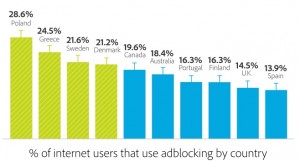The Alarming Increase in Ad Blocking
 Earlier this week, the French paper Les Echos (English Coverage) broke the story that two major organizations, GESTE, an organization of French online content editors, and the French Internet Advertising Bureau are contemplating a lawsuit against Eyeo GmbH, the company behind the popular AdBlockPlus extension.
Earlier this week, the French paper Les Echos (English Coverage) broke the story that two major organizations, GESTE, an organization of French online content editors, and the French Internet Advertising Bureau are contemplating a lawsuit against Eyeo GmbH, the company behind the popular AdBlockPlus extension.
Though GESTE says it is just at the consulting phase and no lawsuit is imminent, the mere fact such organizations would contemplate such a lawsuit highlights the growing concern over ad blocking software online.
But why is that concern coming to a head now? After all, Ad blocking has been around for years and public battles over it have been going on for almost as long. For example, in 2010 Ars Technica altered its site to block its non-advertising content to those who used ad blocking software. Though the site backed off the change, the controversy over it sparked a lengthy and tense debate on the subject.
What’s changed in 2014 isn’t that ad blocking has become more effective, but that ad blocking has grown significantly and, with that growth, the impact it is having has been increasing. Even as spending on online advertising surges (even as other types of advertising continue to decline), many are worried that publishers and creators aren’t seeing all of the revenue from their creations.
So how serious is this increase? The numbers, at least according to one study, are quite amazing.
The Surge in Ad Blocking
 PageFair is a company that aims to help companies recoup revenue lost from ad blocking. In September they partnered with Adobe to publish a study about the state of ad blocking and their numbers were frightening to many who count on advertising as a business model.
PageFair is a company that aims to help companies recoup revenue lost from ad blocking. In September they partnered with Adobe to publish a study about the state of ad blocking and their numbers were frightening to many who count on advertising as a business model.
According to their research, there are currently 144 million active users of ad blocking plugins. That represents nearly 5% of all Internet users.
However, in January 2013, that number was just 54 million. Ad blocking grew by 117% percent in 2013 alone and 166% growth over the year and half since January 2013. This means, for every active user of ad blocking plugins in January 2013, there are currently over two and a half.
This type of rapid growth is unprecedented in ad blocking. For example, during 2012, ad blocking only rose from 39 million to 54 million, a growth of 43%. In 2012 it grew from 30 million to 39 million, representing a growth of 30%. While both numbers are still impressive, they are far shy of the more recent trend.
 To make matters even more complicated, ad blocking is heavily clustered in western nations with countries like Poland, Greece, Sweden and Denmark all seeing higher than 20% ad blocking. So while global adoption may only be 5%, in some countries more than a fifth of their Internet users (combined mobile and desktop) are actively blocking ads.
To make matters even more complicated, ad blocking is heavily clustered in western nations with countries like Poland, Greece, Sweden and Denmark all seeing higher than 20% ad blocking. So while global adoption may only be 5%, in some countries more than a fifth of their Internet users (combined mobile and desktop) are actively blocking ads.
As far as what’s spurring the growth, PageFair says that the rise is largely attached to Google Chrome and Firefox. Since 94% of all ad blocking takes place on user-installed browsers (rather than pre-installed ones such as IE and Safari). Where only 2.1 percent of IE users use ad blocking, over 30% of Chrome and Firefox users do. Google Chrome alone makes up some 63% of users of ad blocking tools.
But while the rise of alternative browsers certainly does play a role, it can’t explain the entirety of the growth. After all, Firefox and Chrome have been available since long before 2012. The sudden spike has to have an additional explanation.
Critical Mass, Critical Damage
The frustration over advertising online has not subsided over the past few years. If anything, it has gotten worse. Video ads, interstitial ads, popup ads, pre-roll ads, mid-roll ads and whole site sponsorships have put more advertising in front of people and an increasing amount of it blocks content from being viewed.
Couple that frustration with the fact that, according to PageFair, nearly half of all ad blockers learned about it from word of mouth and the stage is set for explosive growth. More people are talking about ads and more people are there to guide friends and family into using ad blockers.
Whenever you have something that grows largely by word of mouth, the more people are talking about the problem it resolves and the more people using the product/service, the faster it grows. It’s that simple.
Of course, as ad blocking grows, publishers will need to get more money from those who don’t block ads, resulting in more advertisements and more aggressive forms of marketing. That, in turn, pushes more to seek ad blocking solutions and a cycle is formed.
Ad blocking, it seems, has reached a critical mass and, barring a significant change, is likely to continue growing rapidly. A projection by PageFair shows ad blocking being present on 40% of all desktop computers visiting its customers sites by mid-2015 (it is currently at 25%). Given the recent rapid growth, that is not entirely out of the question.
As PageFair put it, ad blocking has gone mainstream and it isn’t likely to go back.
Advertisers and Publishers to Respond
The rise of ad blocking doesn’t mean that advertisers, webmastsers and publishers will stop trying to make money from visitors, it just means they will seek out other ways.
If nearly half of all desktop visitors do begin using ad blocking technology, it’s inevitable that publishers will respond and, as I noted earlier, that response may actually hurt ad blockers.
For publishers and creators, there are three basic choices:
- Withholding Content: We’re already seeing some video providers refusing to play the main video until ad blocking software is disabled an an advertisement is played. As Ars Technica showed in 2010, this can be done for any type of content.
- Paid Cotent Models: Many news sites are already moving their content behind paywalls or requiring subscriptions to view more than a few articles per month, regardless of advertising. Charging directly for access to content is not a new model, but one that eliminates the impact of ad blocking.
- Native Advertising: Ad blocking requires a separation between desired content and advertising. However, sponsored posts, product placement in a video itself, etc. can’t be filtered easily without eliminating desired content.
These three choices are not mutually exclusive. For example, a recent New York Times piece on women in prison, which was sponsored by Netflix to promote “Orange is the New Black” is a regularly cited example of native advertising done well. However, viewing the page with ad blocking software strips out the images and videos, the bulk of the content. In short, it not only is a form of native advertising, but it denies access to content to ad blockers.
But all three of these models do share one important thing. They are widely disliked. The uproar over Ars Technica’s move in 2010, John Oliver’s recent rant against native advertising and guides on circumventing paywalls shows that the public isn’t too keen on any of these answers either.
The only models that seems to be reasonably accepted are paywall models that give access to additional features, such as Reddit Gold, or community support models that ask people voluntarily to pay for the removal of advertising, such as the recently announced Google Contributor program.
Those revenue streams aside, it’s clear that ad blocking is pushing sites away from the advertising model, at least exclusively, but is also pushing them toward even less-desirable options.
Bottom Line
If you run a website that depends on advertising for revenue, whether in part or in whole, it’s already likely that a large percentage of your visitors are blocking your ads and that percentage is likely to increase drastically over the next 2-3 years.
While there is no easy answer on how to respond to it, the time to be thinking about it and taking steps is now. Opening new revenue streams today can help guard against future losses.
Internet advertising is not going away but neither is ad blocking. Right now though, in the game of cat and mouse between the two, ad blockers have the upper hand. However, the relatively small number of ad blockers meant there was little motivation to battle them.
That is likely to change in the next two years as ad blocking becomes a bigger drain on revenues. But with the quick rise, any response is likely to come too late for many webmaster who are already struggling to get by.
Even if ad blocking hasn’t hurt your bottom line to date it likely will sometime soon and it’s best to be prepared for that than simply hope for the best.
Want to Reuse or Republish this Content?
If you want to feature this article in your site, classroom or elsewhere, just let us know! We usually grant permission within 24 hours.
